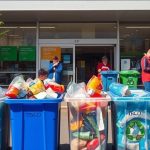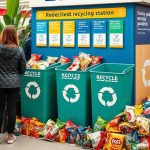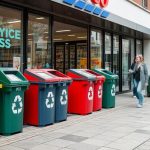Tesco Soft Plastic Recycling Scheme: How It Works
Tesco’s new soft plastic recycling programme is a game-changer for UK recycling. It’s now available in nearly 200 stores across the country. This scheme tackles plastic waste that regular recycling often misses.
The initiative solves a big environmental problem. Only 13% of local councils currently recycle cling film. Tesco’s drop-off points for soft plastics offer a practical solution to this issue.
Customers can easily join in by bringing common plastic items to collection points. These include bread bags, fruit packaging, crisp packets, and salad bags. This simple act helps keep loads of plastic out of landfills.
Tesco plans to collect 1,000 tonnes of soft plastic yearly. This shows their strong commitment to the environment. In trial runs, they collected about one tonne of soft plastic daily across 171 stores.
The scheme is a big step towards less plastic waste. Tesco has already removed over 1 billion pieces of plastic in the past year. They’ve also cut down plastic packaging by about 3,500 tonnes annually.
Understanding Tesco’s Recycling Programme
Tesco’s innovative 4Rs packaging strategy tackles plastic waste head-on. This approach centres on removing, reducing, reusing, and recycling plastic across their operations. Their sustainable packaging efforts have made significant strides in waste reduction.
The retailer’s initiatives have prevented over a billion plastic pieces from becoming waste. Their commitment to sustainable packaging has cut packaging weight by 3,500 tonnes yearly.
- Remove unnecessary plastic packaging
- Reduce overall plastic consumption
- Reuse packaging where possible
- Recycle materials effectively
Partnerships are key to Tesco’s recycling success. They work with Veolia and the World Wide Fund for Nature (WWF). These collaborations enhance their recycling solutions and sustainable packaging approaches.
| Recycling Initiative | Impact |
|---|---|
| Plastic Pieces Removed | Over 1 billion |
| Annual Packaging Weight Reduction | 3,500 tonnes |
| Recycling Points | 171 stores |
In the UK, 47.3% of plastic packaging waste is recycled. Tesco’s programme boosts these national efforts significantly. It also encourages customers to adopt more eco-friendly habits in their daily lives.
Tesco Soft Plastic Recycling Scheme: Essential Information
Tesco has launched a game-changing soft plastic recycling scheme across the UK. This initiative aims to slash plastic waste and promote eco-friendly packaging disposal.
The scheme marks a crucial step towards reducing our environmental footprint. Recycling points are available in about 200 Tesco stores, mainly in South West England and Wales.
Collection Points and Accessibility
Finding Tesco’s soft plastic recycling points is a breeze. You can use their online store locator, check in-store signs, or ask customer service staff.
- Use Tesco’s online store locator
- Check in-store signage
- Consult customer service representatives
Processing and Handling
The recycling process involves several steps to maximise environmental benefits. These steps ensure that soft plastics are properly recycled and repurposed.
- Collection: Gathering soft plastic materials from designated recycling points
- Sorting: Separating different types of plastic packaging
- Cleaning: Removing contaminants and preparing materials for recycling
- Processing: Transforming collected plastics into new usable materials
| Recycling Stage | Key Actions |
|---|---|
| Initial Collection | Customers deposit soft plastics at Tesco stores |
| Material Preparation | Plastics are cleaned and sorted by type |
| Transformation | Converted into new packaging or products |
Your participation in Tesco’s soft plastic collection scheme makes a real difference. You’re helping to cut waste and support sustainable practices.
Acceptable Materials for Recycling
Tesco’s plastic packaging recycling programme offers a novel way to recycle soft plastics. This scheme tackles materials that traditional recycling can’t handle. Following Tesco’s guidelines helps shoppers contribute to better waste management.
The programme accepts a wide range of soft plastic materials. This makes it easier for customers to recycle household packaging. Proper identification of recyclable items is crucial for successful recycling efforts.
- Cling film and food wrapping
- Salad bags and produce packaging
- Crisp packets
- Bread bags
- Flexible pouches
- Magazine and newspaper wrappers
“Our goal is to make recycling soft plastics as simple and accessible as possible for our customers,” says a Tesco representative.
Customers should ensure materials are clean and free from food residue. Removing labels also helps improve the recycling process efficiency.
| Recyclable Materials | Not Acceptable Items |
|---|---|
| Plastic food packaging | Hard plastics |
| Soft sandwich bags | Metal-lined packaging |
| Plastic film | Compostable plastics |
The UK’s recycling infrastructure is growing, with Tesco leading in soft plastic recycling. By 2026/27, kerbside collection for soft plastics should be widely available across England.
Environmental Impact and Achievements
Tesco’s plastic waste reduction efforts have shown impressive results. They’ve transformed packaging practices and minimised environmental impact through innovative recycling initiatives.
The retailer has made significant strides in sustainability. Their achievements are a testament to their commitment to environmental responsibility.
Tesco’s recycling programme has had a substantial impact. Here are their key achievements:
- Removal of nearly 1.5 billion pieces of plastic since 2019
- Improved packaging for over 1,600 products
- Saving more than 6,000 tonnes of material
Waste Reduction Statistics
Tesco has set up soft plastic recycling points in about 900 stores. They’ve collected 500 tonnes of soft plastic so far.
The company boasts an impressive recycling rate of over 80%. This shows their commitment to effective waste management.
Sustainability Goals
Tesco aims to create a circular economy as part of their long-term strategy. Their ambitious goals include:
- Collecting over 1,000 tonnes of soft plastic annually
- Ensuring packaging is widely recyclable at kerbside
- Achieving a recycling rate of 75% or more
Tesco’s innovative approach shows their dedication to reducing plastic waste. It also promotes environmental responsibility in the retail sector.
From Waste to Resource: The Recycling Journey
Tesco’s recycling scheme turns discarded soft plastics into valuable resources. This innovative approach tackles the critical issue of plastic waste management. It shows how we can reimagine and repurpose waste materials.
Specialised recycling facilities transform collected soft plastics through a detailed process. This includes cleaning, sorting, and breaking down plastics into high-quality pellets. These pellets are then converted into new plastic products.
The UK uses nearly 400,000 tonnes of soft plastics yearly. Yet only 21,000 tonnes are successfully recycled. Tesco’s initiative aims to improve these figures significantly.
The circular economy model is key to this process. It transforms plastic waste into new packaging and products. This reduces environmental impact and creates a sustainable loop of material usage.
Tesco commits to using at least 30% recycled material in new packaging. This step further supports the circular economy approach.
Our goal is to turn waste into a valuable resource, reducing environmental burden and creating sustainable solutions.
Advanced technologies like pyrolysis convert plastic into oil. This oil can replace fossil fuels in creating new plastic pellets. This innovative method shows how recycling can benefit both the environment and economy.
Community and Educational Initiatives
Tesco leads the way in sustainability awareness through innovative community projects. They partner with Veolia and Groundwork to develop engaging programmes. These initiatives connect environmental learning with practical action.
Tesco’s recycling education goes beyond traditional classroom teaching. Their community projects create hands-on experiences for students. They introduce sustainable practices through interactive initiatives.
The retailer donates planters made from recycled soft plastics to schools. This approach demonstrates practical applications of circular economy principles. It helps students understand the value of reusing materials.
School Programmes
Tesco’s school programme includes giving out fruit trees and strawberry plants. This helps children understand environmental stewardship. Students learn recycling techniques and engage directly with ecological concepts.
By turning waste into gardening resources, Tesco offers practical learning experiences. These inspire future generations to prioritise environmental responsibility. The programmes aim to develop eco-conscious attitudes among young learners.
Tesco’s commitment to sustainability education aligns with their strategy to reduce plastic waste. Currently, only 7% of soft plastics are recycled in the UK. These school programmes play a vital role in raising awareness.
FAQ
What types of soft plastics can I recycle at Tesco?
Tesco accepts many soft plastics, including food packaging, crisp packets, and bread bags. They also take salad bags and magazine wraps. Clean items thoroughly before recycling.
Where can I find soft plastic recycling points in Tesco stores?
Recycling points are usually near store entrances or checkouts. Use Tesco’s website to find the nearest collection point. Check for availability before visiting.
How does Tesco process the collected soft plastics?
Tesco partners with Veolia to handle soft plastics. They sort, clean, and transform materials into new products. This approach supports a circular economy for waste management.
What are Tesco’s sustainability goals related to plastic reduction?
Tesco aims to remove over one billion plastic pieces from its operations. They’re committed to reducing packaging weight. The soft plastic recycling scheme is crucial to their sustainability strategy.
Can I recycle plastic film and bags through this scheme?
Yes, plastic bags and food packaging films are generally accepted. Check your local Tesco store’s guidelines for specific details. They may have unique requirements.
How does Tesco’s recycling programme benefit the environment?
The scheme reduces landfill waste and conserves resources. It also lowers carbon emissions by reusing soft plastics. Tesco works with WWF to maximise the programme’s environmental impact.
Are there any materials that cannot be recycled in this scheme?
Hard plastics, contaminated packaging, and non-plastic materials aren’t accepted. Clean items thoroughly before recycling. Remove labels where possible to improve recyclability.
How can schools get involved with Tesco’s recycling initiatives?
Tesco works with Veolia Orchard and Groundwork on educational programmes. They create planters from recycled soft plastics for schools. This helps raise awareness about recycling and sustainability.
What happens to the plastics after they are collected?
Collected soft plastics are sorted, cleaned, and processed into new materials. They’re transformed into packaging, construction materials, or other useful products. This supports a circular economy approach.
How can I ensure I’m recycling soft plastics correctly?
Clean and dry items before recycling. Remove non-plastic components like labels or clips. Check Tesco’s guidelines and use the dedicated in-store recycling points.















